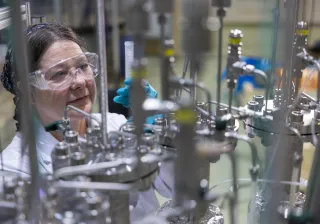Companies and research institutes involved in the development of electronics and optics will begin co-operation under the leadership of VTT. The objective of the two-year research and development project funded by Business Finland is to create recyclable and compostable electronics and optics that use renewable resources.
Smart packages and disposable travel cards are excellent examples of the increasing applications of electronics. Smart packages communicate wirelessly with consumers and the entire supply chain, and disposable travel cards are easy to read remotely by card readers. However, as there are more applications, there is also more electronic waste. It is time to ensure that electronic materials and manufacturing methods are developed to enhance their ecological sustainability. This is the goal of the two-year ECOtronics project, amounting to 4.2 million euros in value.
Several companies and research institutes are developing materials, manufacturing methods and products for electronics and optics each on their own, and many of them have also tackled the environmental issues. In this project, the new and totally unique aspect is that a group of up to nine companies and four research institutes will join forces to examine the environmental responsibility issues related to electronics and optics. The project supports the development of novel, environmentally friendly products seeking inspiration from, for example, the EU ecodesign directive.
The project is also attracting interest in the European electronics industry.
Biodegradable roll-to-roll electronics
The ECOtronics project aims to use materials that can be safely recycled, composted or even left to decompose in nature. Biodegradable materials will be necessary, for example, in devices used for measuring soil or other environmental conditions. In the project, the materials R&D will focus on substrate materials used as a base for electronic and optical components, replacing the traditional circuit board materials.
As far as production methods are concerned, the project is strongly focused on printing methods by which electronics and optics can be produced directly on thin, roll-to-roll base materials. As an additive manufacturing method, printing fully fills in the component materials so no waste is produced in the manufacturing process.
We are already producing cables using roll-to-roll techniques, but we want to develop the materials further to make them even more environmentally friendly. I believe that the ECOtronics project will support our goal in many different ways.
Alongside materials and manufacturing methods, the project will also examine the whole product life cycle, starting from raw material manufacturing all the way to waste processing. The project will draw up Life Cycle Analyses for the solutions developed and compare them to solutions already in use.
In addition to New Cable Corporation, the other Finnish partners in the project are Iscent, Paptic, Green Company Effect, Stora Enso, Vaisala, GE Healthcare Finland and Confidex, and the French partner is Total R&D. The other research partners alongside VTT are University of Tampere, Lappeenranta University of Technology (LUT) and Lahti University of Applied Sciences. VTT's contributions to the project include a pilot manufacturing facility for printed intelligence and long-term experience from the development of bio-based materials.




